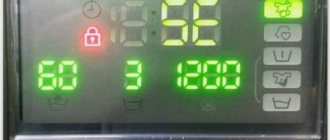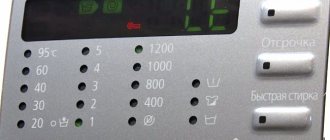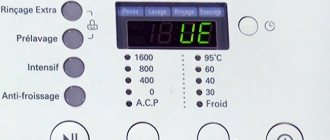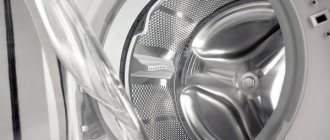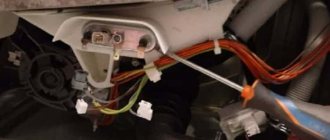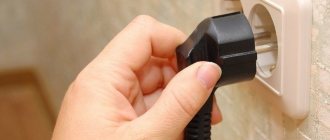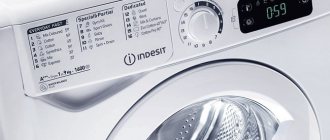There is a leak from under the gasket of the inlet (inlet) hose of the washing machine, what should I do?
The washing machine is relatively new, it was installed by a professional.
It's leaking from under the gasket, we tried tightening the nut more, but it didn't help, what should I do?
This is simply terrible for some who have encountered a leak from under the water supply hose to the washing machine.
I’ll tell you my story of torment, maybe this information will be useful to someone.
So, it all started after I connected the washing machine in a new apartment that had just been renovated. I didn’t change the hose, the gaskets also looked good, so I installed the old ones. After the first wash, I checked for leaks and pushed the machine against the wall, thereby blocking the view of the rear wall with the hoses.
After 3 months I discovered a leak, or rather it started earlier, but not in large portions, taking into account the fact that I do not turn off part of the cold water supply tap.
The leak appeared where the hose is screwed to the pipe.
My first thought is that I probably didn’t press it too hard, since all the parts are plastic and you’re afraid of damaging them when you press them.
Then my torment began, I’ll just describe it so as not to take up much time:
1) I pressed the nut harder, watched the leak for a week, during this time they washed it twice, but after a month it started pouring, and in the morning there was a puddle on the floor.
2) I replaced the gasket, bought a rubber one at the store, it is not soft. I struggled with it for a couple of weeks and had to take it off.
3) I bought a silicone one at the market, and after a month it started leaking.
4) I decided to replace the entire hose, since it seemed that the hose was turning a little when rolled. I watched the leak for about 2 weeks, everything was dry.
5) After about 2 months, in the morning I found a puddle in the bathroom, leaking at the same connection. I decided to check the faucet with the pipe, disconnected the hose and installed a plug. I dried the connection, and during the week before washing it didn’t even get wet, although the system was under pressure all the time.
6) I disassembled the old hose and tried to find out what was happening there. It seemed that the gasket, when you press it with a nut, rises at the edges, which may cause a leak. I decided to install a silicone gasket.
7) A month later, the hose connection to the machine began to leak. Without hesitation, I dried the connection and also put it on silicone.
Everything has been dry for six months now, I don’t understand what happened during this year, before these problems we had been using the machine for 4 years and there were no problems.
Silicone used Mannol, 100 rubles per tube. From personal experience I know that this sealant is not of particularly good quality, but I took it on purpose so that later it could be torn off when dismantling the hose.
Source
Poor joining of plastic and rubber components in the hose
A leak may also appear inside the hose. Where its plastic and rubber components meet. They are fixed to each other using a metal frame. The reason may be that the part of the hose that is made of rubber has lost its elasticity over time, worn out, and changed shape. In such a situation, the pressure of the fixing metal band may become weaker. And this will lead to a leak.
This problem also occurs when moving the machine, changing its location or moving. If this malfunction occurs, you should try tightening the fastener further. You can also fix the hose in a position in which water will not leak. But all these are just temporary solutions. And we do not recommend resorting to them because the leak may resume. The recommended solution to this problem is to replace the hose. You can easily find a new hose in stores that sell plumbing supplies. The hoses are again not expensive and such a purchase will not put a strain on the family budget.
[custom_ads_shortcode1]
The inlet hose for the washing machine is leaking, leaking
If you notice that your washing machine has started to leak, this can happen for various reasons. Including due to a leak in the inlet hose. At first glance, it seems that solving the inconvenience that has arisen is not quite difficult. But it is not always the case. And this malfunction can cause some problems. You may decide that in order to fix the damage, you just need to tighten the hose connections harder. Unfortunately, this method does not always help. Let's take a closer look at this issue and discuss the typical places in the hose where leaks most often occur. And some reasons that can cause this.
How to find a fault?
The first thing you need to do when starting to look for the cause of water leakage is to turn off the power to the washing machine. Check if the water drain filter is clogged. Perhaps the reason is that it is not closed well, so water leaks out. Typically, the drain filter is located at the bottom of the machine body, under the front strip. Manufacturers often build it under a special cover that opens easily. If there is no such cover, you will have to completely unscrew the bottom plastic panel.
You can then inspect the drain hose and where it connects to the machine's drain pump. For most well-known brands of washing machines (LG, Samsung, Indesit, Ariston, Whirpool, Candy, Beko, Ardo), you can get to the hose connection through the bottom of the machine. Just lay it on its side and see how tightly and tightly the hose is screwed to the pump.
In cars under the Electrolux and Zanussi brands, to check the connection location, you will have to remove the back cover of the case. The connection between the drain hose and the drain pump in machines under the Bosch and Siemens brands is difficult to access. You will have to disassemble the front of the machine, first removing the powder tray and cuff.
Having ruled out the drain hose as the cause of the washing machine leaking from below during the spin cycle, we move on to inspecting the seals and bearings. When the seals wear out, water drips appear on the back of the machine drum. To see all this you will have to remove the back cover of the case. As for the bearings, their failure is accompanied by a grinding noise during drum rotation.
If the above reasons were excluded during the inspection, one thing remains - the drain pump is broken. However, we remind you that only a specialist can accurately diagnose the reasons why water flows from the machine during the spin cycle.
Corrective Actions
The most solvable problem is a malfunction of the drain filter. If the filter is clean, but it cannot be tightened tightly because the thread is broken, then it needs to be replaced. Buy a similar filter in the store and install it in place.
With simple plumbing skills, you can replace the drain hose yourself if the cause of water leakage is in it. We described above how to get to the place where the hose is connected to the machine, then you need to:
- pull out the drain hose from the sewer outlet;
- using a screwdriver, loosen the clamp securing the hose to the pump;
- remove the drain hose from the drain pump;
- remove all fasteners securing the hose;
- take a new hose and connect it to the pump and then to the drain pipe outlet.
You can read the entire process in detail for different brands of washing machines in the article about replacing the drain hose.
If you need to replace seals or bearings in a washing machine, you need to almost completely disassemble the machine itself, because you won’t be able to get to them otherwise. Few people decide to undertake such home repair work. For those who nevertheless set the goal of eliminating such a malfunction on their own, our website has an article “How to replace the tank seal?”
In addition, you can watch a video recording that will help you repair your car, as well as evaluate the complexity of such repairs.
If the reason that the washing machine leaks during the spin cycle turns out to be a broken drain pump, then in this case you will also have to do serious work, not to mention the cost of purchasing a new similar part.
In conclusion, we note that if water flows from the washing machine during the spin process, this may indicate a serious malfunction. So the malfunction makes itself felt precisely during the spin process, when the machine is running at full power, at high speeds. Whatever the problem, it must be solved as soon as possible, otherwise it will lead to the most unfavorable consequences.
Not a reliable enough connection
One of the reasons for a water leak may be an insufficiently reliable connection between the hose and the water pipe or washing machine. Or wear of the rubber gasket, which is located at the joints of the hose. Over time and under the influence of mechanical factors, it may slightly change its shape. May become less elastic. This is what will cause a leak. Typically, this problem occurs after moving the washing machine. Or after moving it to another apartment and a new installation.
In order to get rid of this problem, it is enough to buy a new gasket and install it in place of the old one. Gaskets can be purchased at plumbing supply stores. In order not to be mistaken in size, you can take an old gasket with you and compare it with the one you will buy. Gaskets cost mere pennies, there are usually quite a lot of them in such stores, so there shouldn’t be any problems with the purchase.
Incorrect hose position
It is necessary that the hose is in the correct position in relation to the connection points with the washing machine and the water pipe. The part of the inlet hose that is made of plastic and is located inside under the rubber gasket must be in the correct position. Such that, in a twisted state, it will evenly press on the gasket from all sides. If there is less pressure in some part, then water leakage may occur there.
If this is the problem of leakage, then it is enough to correctly place the inlet hose of the washing machine and tighten its connecting points a little more tightly.
Troubleshooting
After turning off the machine and de-energizing it, disconnecting it from the water supply, we perform an external inspection to determine why the water is leaking. To carry out this inspection, you may need to tilt the washing machine or remove the back or side covers of the machine. It will be much easier to find the faulty part if you have determined at what cycle of operation the leak began to appear.
Hose damage
Damage to hoses, their premature wear and poor connection at the joints is the most common reason why a machine may leak.
Inlet hose leak
A leak in the inlet hose can be detected even when the machine is not running. If you have established for sure that there is a defect in the inlet hose, then it is not advisable to repair it, since the water pressure supplied to the washing machine system is quite high. If necessary, this hose must be replaced with a new one. And if the seal is broken at the junction of the hose with the machine components, it is necessary to change the gasket and tighten it well. In order not to break the plastic elements of the hose, you need to clamp it exclusively with your hands without using additional tools.
The drain hose may be leaking
Leaking pipe
If there is a leak during water intake, which disappears after filling the tank, the most likely cause may be damage to the pipe connecting the fill valve to the powder receiver hopper. To carry out an external inspection of this unit, you will need to remove the cover from the Samsung washing machine.
Damage to the drain pipe can also cause water to leak from below. This pipe connects the tank to the drain pump. To examine it, you need to look from below, after tilting the washing machine.
poor connection between the pipe and the tank
Damage to the drain pump
If, during washing, you find water leaking in the area of the drain pump from below, then perhaps it has become unusable or damaged. To carry out a high-quality visual inspection of this unit, it must be completely dismantled. A faulty drain pump must be replaced, so professional assistance may be required.
The cuff is leaking
When washing laundry, in which careless owners sometimes forget some small items in their pockets, the sealing collar of the washing machine door may be damaged. Such damage is clearly visible in machines with horizontal loading of laundry.
If the damage is not very large, then it can be repaired using a rubber patch and special waterproof glue. After sealing the hole, it is better to turn the cuff over with the patch facing up, since with this arrangement the water load on it will be less, which can increase its service life. If the seal is damaged internally, it must be removed from the unit.
Of course, it is advisable to replace the defective cuff with a new one.
Damage to the washing machine tank
To inspect the tub of a top-loading washing machine, you will need to tilt it to check the bottom for water droplets from below. It is good to use a hand-held flashlight. If the washing machine is top-loading, you will have to remove the side wall. Tank failure may occur due to the presence of foreign solid objects or a malfunction of the heating element.
If the tank consists of two halves, then the leak may occur due to the drying out of the sealing gasket between them. Such a malfunction is extremely rare and requires replacement of the gasket.
Oil seal malfunction
As a rule, a malfunction of the oil seal during washing is difficult to determine; it becomes noticeable when the machine is operating in spin mode. If you notice that the tank seal is leaking, you must immediately stop operating the machine to avoid more serious damage to the unit.
Repairing such a malfunction involves replacing the worn oil seal or bearing with new parts. Such work requires the involvement of washing machine repair professionals from the workshop.
Leakage through the dispenser
Water may leak during washing if the dispenser hopper is clogged with powder residue or a foreign object. To eliminate the cause of the leak, you need to remove the dispenser and clean it and the hopper from obstructive contaminants.
Leakage through the dispenser is also possible due to excessive water pressure in the system and due to problems with the inlet valve. This problem can be eliminated by reducing the water pressure.
Replacing the hose
Replacing the inlet hose is very simple.
You just need to turn off the water supply. Then unscrew the old hose from the water supply and from the washing machine. And then screw on the new hose. After this, open the water supply and examine the hose for leaks. If you did everything correctly, then they will not exist. If they appear, it means that you did not tighten the connections tightly enough, or you lost the gasket. You also need to pay attention to the fact that these places cannot be twisted. Because if you tighten it too tightly, you can strip the threads or damage the gasket. And if you have a lot of strength, then do it carefully.
It also happens that there is a leak from the rubber part of the hose. It appears due to improper use, mechanical damage and other cases. With such a breakdown, there is no need to be too smart. You can simply replace the damaged hose with a new one.
Interesting:
- Share your opinion - leave a comment
Source
First steps: what needs to be done?
As soon as you notice that your washing machine is leaking, you need to immediately take measures to protect yourself and your apartment from unpleasant consequences. To get started, follow these steps:
- Unplug the machine, making sure not to step in a puddle to avoid electric shock. If you cannot reach the outlet from a dry area, turn off the electricity in the entire apartment (house).
- Shut off the water supply to the household appliance by closing the intake valve or completely turning off the water supply in the apartment.
- Drain the water from the washing machine tank using the emergency hose or drain filter (they are located below the loading hatch).
- Remove the laundry from the drum and begin inspecting the equipment.
After eliminating local flooding around the machine, do not forget to drain the water from the device itself
Most manufacturers of washing machines (LG, Beko, Samsung, Bosch, etc.) equip their equipment with a leakage protection system. What does it mean? If any of the components leaks, the Aquastop function blocks further water supply and its distribution to vital parts of the machine, for example, the control panel. This prevents flooding of the apartment and associated troubles.
Before repairing the unit, you need to disconnect it from the network and drain the water from the tank. Remember, it is important to follow safety precautions so as not to endanger life and health.
The water supply hose of the washing machine is leaking: what to do?
The washing machine is one of the main household appliances. It will help keep clothes clean, so any malfunctions are critical. If something happens, you need to call a specialist, although there are breakdowns that are not difficult to fix on your own.
A leaking washing machine hose is not uncommon. The problem is indicated by a puddle on the floor during washing. You shouldn’t let the problem take its course and persistently soak it in the water. Such a malfunction is fraught with short circuits and electric shocks to household members. It is necessary to determine the exact malfunction. Among the possible options are breakdowns, kinks, defects in the hose, or the hose remains intact, but the leak occurs due to an incorrect connection between the structure and the water supply part. A poor connection also leads to leaks; it occurs if the technician has not tightened the structure properly and there is a gap left.
Make sure the hose is in the correct position. If it is bent or pinched, leaks occur. Reinstallation will solve the issue - you just need to change the location of the node. Wear of the gasket also leads to leaks. As a result of increased water pressure in the system and mechanical stress, the gaskets wear out and a leak occurs. Possibility, difficulty with poor-quality joining of rubber and plastic inside the hose. Rubber does not last forever; over time, it loses its original shape and elasticity. The quality of fixation suffers, water oozes out during washing.
It is not difficult to replace the hose on your own; it is not necessary to contact a specialist for these purposes. You need to turn off the water supply using the valve, remove the old hose from the machine, and unscrew its connection points to the water supply system. After connecting the new product, properly tighten the fasteners, turn on the water.
Be sure to check if the leak is still there. If the twist is tight and the hose is installed at the correct angle, there should be no leakage. The presence of a leak after replacement is a reason to tighten the nuts in the fastening areas more tightly. You should not pinch anything, as this can lead to thread breakage. It would be better to try again and tighten the nuts according to the threads.
Another option for eliminating a leak is to extend the hose. For normal operation of the machine, the length of the product should be up to 3 m; less than necessary is also undesirable. If the working fragment is short, it is expanded.
Do you have anything to say on the issue?
Source
How to fix it?
Let's consider several options for fixing the problem.
If during the inspection it was discovered that water is leaking from the tank, the device will need to be repaired. Most likely the cause is a broken hose and will need to be replaced. If it turns out that water is flowing from under the device door, most likely the hatch seal was damaged. A leak does not always occur due to a breakdown - it could also be the fault of the user. If you notice a leak after a few minutes of washing, you need to check how tightly the filter door and the device itself are closed, as well as whether the hose is inserted well. This advice is most relevant if the machine's garbage filter has recently been cleaned. Sometimes, after cleaning it, an inexperienced user does not secure this part tightly. If the user is convinced that he has closed the lid tightly, he needs to carefully inspect the place where the drain hose and the pump connect. If the intersection is not tight, a sealant will help solve the problem (be sure to take a waterproof one), but it will be safer to simply replace the parts. Even though water accumulates under the machine, the cause of the problem is sometimes higher. It is necessary to carefully inspect the dispenser (compartment) intended for powders and conditioners. It is often located in the left corner of the machine. Sometimes the dispenser is too dirty, which is why water overflows when spinning and drawing.
It is necessary to inspect both from the inside and outside, paying special attention to the corners - more often than not, leaks appear in these places.
If the user doubts that the leak is due to the powder receptacle (located in the front), the tray must be completely filled with water, wipe the bottom of the compartment with a rag until dry, and then observe the process. If the water begins to flow out slowly, this is definitely the reason. Unfortunately, this part sometimes breaks even in new models of LG machines after 1-2 years of using the device. This problem is associated with the dishonesty of assemblers who wanted to save on parts.
If the user notices that water flows during washing, the reason definitely lies in a broken pipe. To carry out an accurate diagnosis, you need to remove the top wall of the device.
Sometimes the problem occurs due to a leak in the drain pipe, which is directed to the pump from the device’s tank. In order to check this, you need to tilt the machine and look at the inside of the case from below. It is likely that the cause of the breakdown lies precisely in the pipe. To inspect it, you will need to remove the front panel of the machine and examine the area where the connection is located.
If the cause of the leak is a crack in the tank, this is one of the most unpleasant problems. Most often, it is impossible to fix it yourself; you will need to replace the tank, which is expensive. This crack could occur due to frequent washing of shoes, as well as when sharp objects get into the machine: nails, iron inserts from a bra, buttons, paper clips.
The crack could also appear due to a defect made by the manufacturer, but in any case, the device will have to be disassembled in order to remove the tank and carefully inspect it. To carry out such manipulations, it is better to call a specialist, so as not to make things even worse.
If you inspect the unit and find that water is leaking from under the door, the seal lip may be damaged. In this case, the problem can be easily solved - a special patch or waterproof glue will help fix the problem. You can also simply replace the cuff with a new one; it is inexpensive.
The article discussed the most common causes of failure of the LG washing machine, as well as ways to eliminate them. In any case, it is better, if possible, to contact a specialist or service center if the machine is under warranty. To avoid problems in general, you should be more careful with the device and check things before loading them into the tank.
You will learn further about what to do if water is leaking from your LG washing machine.
The inlet hose for the washing machine is leaking, leaking
In some cases, the reason for the formation of a puddle under the washing machine is that the inlet hose of the washing machine is leaking. Despite the apparent simplicity of the problem, it is sometimes not immediately possible to effectively solve it. As a rule, it always seems that it is enough to tighten the connection of the hose to the machine or to the water supply system more tightly, and the leak will stop.
But it doesn't always work out that way. Let's go through the entire inlet hose and figure out where a leak may appear:
- Loosening a threaded connection.
- Incorrect position of the hose relative to the connection itself.
- Connection of the rubber and plastic parts of the hose.
- Damage to the plastic or rubber parts of the hose.
Machine diagnostics and repair tips
Typically, questions about what to do when a leak is detected in the washing machine arise when it is used for a long time without maintenance or due to the owner’s carelessness. For example, a puddle at the bottom of the door is usually due to the fact that objects not intended for washing have entered the drum. In addition, almost any part of the flexible hose can become leaky.
Water accumulates at the door
Water leaks onto the floor from the hatch if the sealing lip does not fit tightly. It may receive mechanical damage when it comes into contact with objects that fall inside the drum. If the seal gets caught in the door ledge when closing it, there is a risk of rupture. With prolonged use, the sealing of the rubber ring may be damaged - it is restored using special compounds.
You can repair small tears and damage to the cuff yourself. An elastic patch made of a material similar in composition can easily be applied to rubber glue. To repair, the part is removed from the mount by loosening the clamp. After placing the patch, the cuff is installed so that the repaired area is above the top of the hatch, under the “roof” of the unit.
The powder tray is leaking
When liquid leaks from the powder compartment under the tray, the cause may be too much water pressure. In addition, if the detergent is not washed out well, it can gradually form a clog in the hopper itself, the outlet or the filter installed there. Sometimes the problem is due to poor quality water leaving calcified deposits inside the powder receptacle.
Fixing a leak in the tray area is quite simple. You can remove mechanical blockages by removing the powder receptacle and thoroughly washing all its parts. The strainer must be cleaned especially carefully. Its contamination most often disrupts the permeability of the system.
Leakage when filling with water
If a leak occurs when drawing water, the machine may have problems with the inlet hose. In the event of mechanical damage, its sealing is broken and cracks are clearly visible on the surface. Sometimes after rearranging furniture or doing other work in the bathroom, the hose gets pinched. If there are no obvious damages along the entire length of the flexible line, but water still leaks onto the floor, you need to conduct a more thorough diagnosis.
The easiest way to determine the damaged area is to disconnect the hose and install a plug on one side. Then it is wrapped in toilet paper and filled with water. A wet spot will appear at the damage site. If the hose is in order, the problem may be that the connection between the flexible line and the fitting is too loose - it is worth checking it and, if necessary, tightening the clamp further.
Leakage during washing
If water gets under the washing machine during the spin or rinse cycle, the problem is in the drainage system. The filter installed here rarely lets liquid through. Leaks usually occur after recent cleaning. If the filter is not tightened tightly, it may leak water when draining. Simply unscrew it and install it in the correct position.
When the machine leaks during washing, a puddle is located in the area where the drain pipe is located; the liquid may remain inside the body or end up under the bottom. The depressurization of the connection is usually associated with vibration effects and cracking of low-grade material. If damage is received precisely at the junction of the pipe with the tank or pump pump, they can only be detected when the machine is completely disconnected from the sewer, after laying it on its side.
The leak may be due to a breakdown of the volute in the pump. If foreign objects get into the drum, they can come into contact with other parts of the system and damage them. Replacing a broken pump is relatively inexpensive; you can easily purchase it in specialized stores and install it yourself.
A leak that occurs at any stage of the wash and continues throughout the entire operation of the machine may be due to a breakdown of the tank. It ceases to be airtight due to washing of products containing metal inclusions. If there is a strong impact, the container cannot withstand it, cracks, and begins to leak water. In this case, you can try to eliminate the leak using polyurethane sealant by completely disassembling the unit and drying it.
Replacing the inlet hose
To replace a damaged inlet hose, you need to carefully perform a few simple steps, observing safety precautions. In order not to make a mistake when purchasing, it is better to take the damaged part with you to the store - then you can check on the spot whether the lengths and diameters of the connecting nuts match the old and new ones. To do this, you must first remove it without damaging the other parts.
Before unscrewing the connecting nuts, you need to turn off the water in the supply tap and wait a few minutes for the pressure to drop. You need to unscrew it carefully, placing a container to drain the remaining water - first near the tap, then from the side of the machine. After installing the new hose, you need to check the tightness of all connections and the water supply tube itself.
Connection of the rubber and plastic parts of the hose
A leak may occur in the hose itself, where the rubber part is connected to the plastic part using an iron clamp. As with the gasket, the rubber hose loses its elasticity over time, and accordingly the pressure of the iron girth weakens and water begins to leak through the connection.
Leaks occur more often when the machine is moved and the old connection is disturbed. To eliminate the leak, you need to correct and firmly fasten the hose to the back wall of the machine. If this does not help, replace the inlet hose.
[custom_ads_shortcode3]
Protective hose for washing machine with Aquastop
A device with protection against leakage is called Aquastop. Standard hoses, which were described above, can rupture - this usually happens due to aging over time. If there are water leaks, flooding may occur.
The pipe with the Aquastop system reduces the risk of leakage to zero.
A hose with a special Aquastop protection device is a system where 1 tube is located inside the second. There is a special material between them; when exposed to water, it swells, which contributes to the activation of the safety valve, which will shut off the water.
Protective hose for washing machine with Aquastop
The system works like this:
- Normal mode - water flows inside through the main inlet hose.
- When damage occurs (tear or slow leak), water acts on the swelling material.
- The material swells, and the valve is activated, the water is shut off, and the floor surface does not get wet.
Such hoses are quite expensive compared to standard ones, but they provide guaranteed protection against leaks and flooding of neighbors. It also happens that the washing machine, even if it is not turned on, produces water; in such a situation, a hose with the Aquastop system will not help.
Causes of leaks
In order to prevent leaks when operating a washing machine, it is useful to know the main reasons causing this malfunction. These include:
- Damage to the casing of the falling pressure hose. Most often it is caused by mechanical stress, improper operation in too warm or cold rooms, or prolonged use, as a result of which the shell loses its elasticity and cracks appear in it. For any type of damage, the hose needs to be replaced; due to its low cost, there is no need for independent repairs.
- The filter built into the hose may become clogged. In this case, excess pressure often causes a leak to appear anywhere in the system. To carry out repairs, remove the hose and clean the filter, after which the liner is put back in place.
- Loosening of the clamping nuts and wear of gaskets can also cause leaks. To troubleshoot problems, the hose is disconnected, the gaskets are changed or the union nuts are tightened.
- Leaks can cause damage to your washing machine. Often, over time, internal water supply tubes lose their physical properties and water can penetrate into the room through cracks in their shell. Often, during operation, the rubber door gasket loses its elasticity, and water leaks through a loose connection. In these situations, washing machine repair specialists are called to troubleshoot problems.
Stages of replacing the drain hose
Leakage when filling with water
If you find that water is leaking in the washing machine already during the cycle, stop the cycle and turn off the water supply. We do not recommend disassembling the entire system to find a defect. But you can find the cause of the problem. Here are the most common ones:
- The supply hose is damaged. Most often, the plastic hose is damaged mechanically. If you examine it carefully, you can easily see the hole. But sometimes the hole is small or in a hard-to-reach place. To detect it, try using a popular test with toilet paper: wrap it around the entire length of the hose and turn on the water supply for a few seconds. The leak is located in the place where the paper is wet.
- The filler pipes are worn out. If this part is made of low-quality material, after 3 years of regular use it will fail. This often happens with Ariston and Candy appliances. If moisture flows below during intake, it means that the pipe is broken. It can be replaced or repaired.
- The powder dispenser is clogged. Sometimes when filling, foamy liquid flows from above the panel from under the powder receptacle. This means that you usually add too much product and it cannot completely dissolve, but only gets wet, hardens and clogs the duct. If possible, remove this container and clean the area behind it with your hands (under no circumstances should you put sharp objects in there). You need to be especially careful with Hansa and Indesit models due to their narrow channels. If the problem cannot be resolved, it is better to contact the specialists from Remontano.
Why does the water supply hose in the washing machine leak?
It is important that the hose is installed correctly with the water pipe, as well as with the washing machine. The plastic part of the inlet hose, which is located inside, must be located under the gasket. The gasket is made of rubber.
When curled, it should apply equal pressure to the gasket on both sides.
In areas with lower pressure, a leak may form during the period when water is supplied. If water flows for this reason, then it is enough that the inlet hose is positioned correctly; the connecting points must be tightened further.
Incorrect position of the hose relative to the connection itself
It is important that the hose is correctly positioned relative to the threaded connection with the machine or with the water supply tap. The plastic, flat part of the hose that is adjacent to the rubber gasket should be perpendicular. If, under the weight of the hose, the plastic part presses unevenly on the gasket, then a leak occurs in a weakened area.
To eliminate this, it is necessary to position the inlet hose so that uniform pressure is applied to the rubber gasket.
[custom_ads_shortcode2]
Full protection
More advanced hose models are equipped with a valve with an electromagnetic sensor controlled by the microcontroller of the washing machine itself. This design will not allow leaks even in cases where damage occurs at the base of the hose inserted inside the device. The outer shell will prevent external leakage: leaked liquid will accumulate in the pan, which is equipped with a sensitive float.
When the sensor is triggered, the microcontroller will send a signal to the protection valve control unit, which will shut off the water. This protection option is implemented in almost all expensive models of washing machines of popular brands (BEKO, Bosch, LG, Siemens, Electrolux, etc.).
I work in the household appliance repair industry. Extensive experience in restoring washing machines and dishwashers.
You won’t be able to install such a hose on any model yourself, because it is controlled by a control module using a program built into it. This is by far the best option, and together with sensors for the presence of water in the washing machine tray, it forms complete protection against leaks.
Inlet hose with aquastop connected to the SMA control module
Connecting the inlet hose for the washing machine
In order to connect the inlet hose to the washing machine, you need to take care to insert it into the water pipe. A tee and shut-off valve should be installed in this place; a plastic nut and fitting should be screwed to the tee. Usually, during the entire period of using the washing machine, these manipulations will not have to be done often, as well as replacing the inlet hose.
Experts recommend additionally installing a special filter together with the insert that will clean the water (in addition to the mesh that is already installed at the entrance to the washing machine).
Due to this, the machine will be protected from contamination. The filter is installed behind the tee, in front of the filler pipe. What to do if the washing machine is not installed next to a water pipe? In this case, 3 inlet hoses are connected.
Connection diagram for the inlet hose for a washing machine
But, it is better to install an additional plastic pipe to the location of the washing machine - like this:
- The risks of water leakage will be lower;
- The device will be durable;
- The system will look aesthetically pleasing.
Accordingly, shut-off taps, one way or another, are installed at the place where the water pipe is inserted. When making connections of plastic pipes, professionals advise using a special tool. After washing, the water supply to the washing machine is shut off.
How to tighten the inlet hose according to the rules? Some owners of household appliances do this with great effort, but this is wrong - there is a high probability of rendering the plastic nuts unusable. It is necessary to do the work manually, without using tools and other improvised means that add force and can damage components. You just need to make a strong connection where the nut will not unscrew and the connection itself will not leak.
